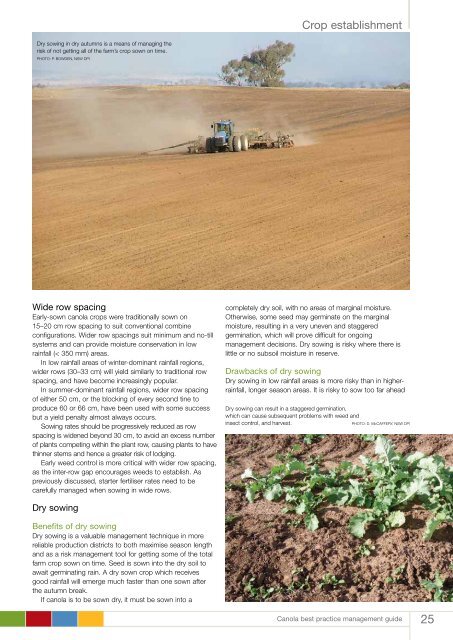best practice management guide for south-eastern Australia - Grains ...
best practice management guide for south-eastern Australia - Grains ...
best practice management guide for south-eastern Australia - Grains ...
Create successful ePaper yourself
Turn your PDF publications into a flip-book with our unique Google optimized e-Paper software.
Crop establishment<br />
Dry sowing in dry autumns is a means of managing the<br />
risk of not getting all of the farm’s crop sown on time.<br />
Photo: P. Bowden, NSW DPI<br />
Wide row spacing<br />
Early-sown canola crops were traditionally sown on<br />
15–20 cm row spacing to suit conventional combine<br />
configurations. Wider row spacings suit minimum and no-till<br />
systems and can provide moisture conservation in low<br />
rainfall (< 350 mm) areas.<br />
In low rainfall areas of winter-dominant rainfall regions,<br />
wider rows (30–33 cm) will yield similarly to traditional row<br />
spacing, and have become increasingly popular.<br />
In summer-dominant rainfall regions, wider row spacing<br />
of either 50 cm, or the blocking of every second tine to<br />
produce 60 or 66 cm, have been used with some success<br />
but a yield penalty almost always occurs.<br />
Sowing rates should be progressively reduced as row<br />
spacing is widened beyond 30 cm, to avoid an excess number<br />
of plants competing within the plant row, causing plants to have<br />
thinner stems and hence a greater risk of lodging.<br />
Early weed control is more critical with wider row spacing,<br />
as the inter-row gap encourages weeds to establish. As<br />
previously discussed, starter fertiliser rates need to be<br />
carefully managed when sowing in wide rows.<br />
completely dry soil, with no areas of marginal moisture.<br />
Otherwise, some seed may germinate on the marginal<br />
moisture, resulting in a very uneven and staggered<br />
germination, which will prove difficult <strong>for</strong> ongoing<br />
<strong>management</strong> decisions. Dry sowing is risky where there is<br />
little or no subsoil moisture in reserve.<br />
Drawbacks of dry sowing<br />
Dry sowing in low rainfall areas is more risky than in higherrainfall,<br />
longer season areas. It is risky to sow too far ahead<br />
Dry sowing can result in a staggered germination,<br />
which can cause subsequent problems with weed and<br />
insect control, and harvest. <br />
Photo: D. McCaffery, NSW DPI<br />
Dry sowing<br />
Benefits of dry sowing<br />
Dry sowing is a valuable <strong>management</strong> technique in more<br />
reliable production districts to both maximise season length<br />
and as a risk <strong>management</strong> tool <strong>for</strong> getting some of the total<br />
farm crop sown on time. Seed is sown into the dry soil to<br />
await germinating rain. A dry sown crop which receives<br />
good rainfall will emerge much faster than one sown after<br />
the autumn break.<br />
If canola is to be sown dry, it must be sown into a<br />
Canola <strong>best</strong> <strong>practice</strong> <strong>management</strong> <strong>guide</strong><br />
25

















